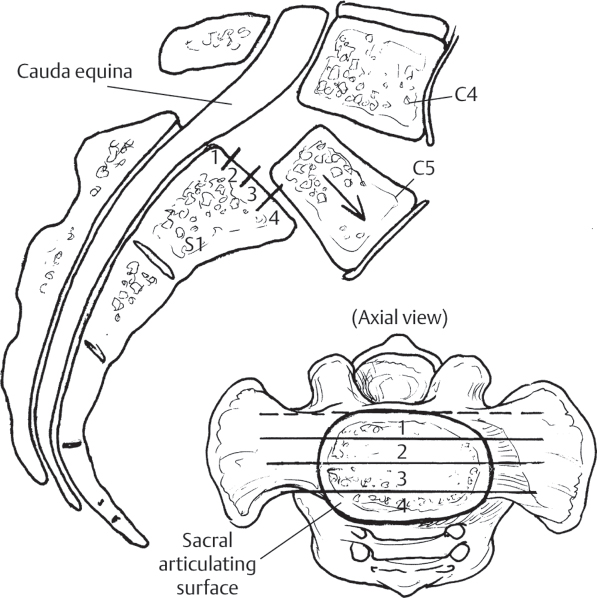45 Spondylolisthesis is the forward slippage of one vertebral body on the subadjacent vertebra. A high-grade spondylolisthesis is one in which the upper vertebral body has slipped more than 50% forward on the lower vertebral body. This is most often seen with a spondylolysis or defect in the pars interarticularis. This type of slip is about four times more common in females than in males and most commonly presents during the school years. The L5–S1 disk space is affected ~ 87% of the time. High-grade spondylolisthesis is more frequent in patients with higher degrees of sacral inclination, meaning that the superior endplate of S1 is oriented more nearly vertically, creating higher shear forces. Wiltse et al. classified the different types of spondylolisthesis based on the etiology (Table 45.1). Spondylolisthesis can also be classified using Meyerding’s system. In this system, the lower vertebral body is divided into quarters. Grade 1 involves a 0–25% slip. Grade 2 is 26–50% slip. Grade 3 is 51–75% slip, and grade 4 is 76–100% slippage. A grade 5 slippage is greater then 100% forward translation of the upper vertebral body and is also called spondyloptosis (Fig 45.1). Patients with high-grade spondylolisthesis often present with back pain and radiculopathy. The radiculopathy generally affects the exiting nerve root at the level of the slip (i.e., a slip at L5/S1 will likely affect the L5 nerve root). Most patients exhibit hamstring tightness, which may lead to a waddling gait (the Phalen-Dickson sign). Physical examination often demonstrates an anterior pelvic tilt with a protruding abdomen or flattened buttocks. A thorough neurological exam should also be performed. Table 45.1 Wiltse and Associates Classification
High-Grade Spondylolisthesis
![]() Classification
Classification
Workup
I – Congenital/Dysplastic | Slippage related to malformation of spinal elements |
II – Isthmic | Fracture in pars interarticularis |
A – Fatigue fracture of articulating segment | |
B – Elongation due to repetitive microfractures without separation | |
C – Acute fracture of articulating segment | |
III – Degenerative | Degeneration of the intervertebral disk or arthritic facet joints |
IV – Traumatic | Acute fracture of the spinal process |
V – Pathologic | Underlying bone pathology (i.e., Paget disease, osteoporosis) |
IV – Iatrogenic/Postoperative | Excess removal of posterior elements following laminectomy |

Fig. 45.1 Meyerding’s grading scale is used to show the amount of slippage of the superior vertebral body on the inferior vertebral body. If slippage is greater then 100%, it is a grade 5 slippage and termed spondyloptosis. This figure demonstrates a grade 3 slippage.
Stay updated, free articles. Join our Telegram channel

Full access? Get Clinical Tree






